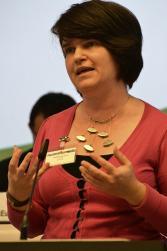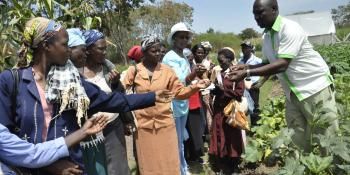Looking beyond agriculture to help create resilient smallholder farms

These were some of the questions discussed during the 29 Brussels Briefing session on climate change, agriculture and food security, organised by the Technical Centre for Agricultural and Rural Cooperation (CTA) and the CGIAR Research Program on Climate Change, Agriculture and Food Security (CCAFS).
Overcoming the obstacles of scaling-up successful agricultural practices
Aslihan Arslan from the Food and Agriculture Organisation of the United Nations (FAO) included a break-down of a CSA project cycle in her presentation, and the role of institutions. “There is a need to better understand barriers to adoption”, she emphasized. “We need to investigate if climate smart agriculture practice are being adopted. And if not, why is this the case? Is it because of institutional, input or financial constraints?” Only then will we understand the barriers to adoption.
There was a general consensus among the presenters that institutions and policies are among the major obstacles in developing countries for rolling out and upscaling CSA practices. “There is a need to build the capacity of institutions in developing countries to better manage implementation of new innovative and successful agricultural practices, that have been created to that particular context” Aslihan said. Investing time, resources and know-how into relevant institutions in developing countries can therefore be one of the first steps towards successful CSA implementation and upscaling.
general consensus among the presenters that institutions and policies are among the major obstacles in developing countries for rolling out and upscaling CSA practices. “There is a need to build the capacity of institutions in developing countries to better manage implementation of new innovative and successful agricultural practices, that have been created to that particular context” Aslihan said. Investing time, resources and know-how into relevant institutions in developing countries can therefore be one of the first steps towards successful CSA implementation and upscaling.
Adapting to climate change, and adapting well
Climate smart agriculture is only one part of the puzzle against a changing climate though. Dr. Sonja Vermeulen emphasized that keeping a key set of adaptation strategies is incremental to stay one step ahead of progressive climate change. For countries it means intensifying the agricultural production in a sustainable way, keep developing relevant technologies as well as include anticipatory policies. Anticipatory policies, such as index based insurance and climate finance support, could assist farmers in managing climate risks, and assist with transformative adaptation such as changing production systems and livelihoods, she explained.
Helping farmers adapt to a changing climate does in other words not just revolve around offering technological advice and resources. Instead it entails packaging information, in a timely manner, that can help farmers make informed decision. Dr. Vermeulen stressed that “adaptation capacity for farmers are never just about technologies”, instead “it is a nexus of interventions, information and knowledge of finance services, land rights and assets and government institutions”. Here CSA practices can be one of many adaptation solutions.
Improving efforts to obtain future food security
What we need moving forward, Dr. Vermeulen suggested, is a landscape approach, which was echoed by Dr. Tony Simons Director General of the World Agroforestry Centre (ICRAF). We need to look beyond agriculture and realize that everything is interconnected. As Dr. Tony Simons put it, many hundred years ago, the earth consisted of 60 per cent forest cover. Today the division is 30 per cent forest and 30 per cent agriculture. When more land is needed to produce food, forests are cleared.
Tony Simons put it, many hundred years ago, the earth consisted of 60 per cent forest cover. Today the division is 30 per cent forest and 30 per cent agriculture. When more land is needed to produce food, forests are cleared.
The immediate issue with the ‘landscape approach’ is the lack of a formal definition, making it difficult to implement. A positive effect from the use of a wider approach for rural development however, is that we can learn from the mistakes made within the United Nations Collaborative Programme on Reducing Emissions from Deforestation and Forest Degradation (REDD). One important lesson is that markets alone won’t solve the problem, as it didn’t solve deforestation.
Moving towards a landscape approach when dealing with climate change and food security is high on the agenda for CCAFS. During COP18, CCAFS will, together with partners, organise “Agriculture, Landscapes and Livelihoods (ALL 5 Day)”, a one-day event that will give voice to a wide cross section of people working on agriculture, forestry, landscapes, food security and rural development. The day provides a unique opportunity for the natural resource and agriculture community to share solutions for climate change adaptation and mitigation in agricultural landscapes.
There is also a need to fill the current gap in how we measure adaptation. It is not easy, but it must be done in order to measure and evaluate different approaches and monitor progress, Dr. Simon emphasised. Coming up with a successful measuring system will be a challenge, but at the same time crucial, to ensure that the best and most beneficial adaptation practices are scaled up.
A third challenge that was mentioned, hindering developing countries to adapt to a changing climate, is that there is poor documentation over successful projects from the field, which could have the potential of being scaled up. In the light of this, CCAFS is currently underway with documenting CSA practices on the ground, and will elaborate on what is needed to upscale innovative projects. The report will be launched later this year, during UNFCCC Climate Change Meeting COP18, in Doha, Qatar.
View the rest of the presentations from the Brussels Briefing.
Watch Sonja Vermeulen's and the other presentations here.
This blog post was written by Cecilia Schubert, Communications Assistant at the CGIAR Research Program on Climate Change, Agriculture and Food Security (CCAFS). To get more updates, follow us on Facebook, and Twitter @Cgiarclimate.


